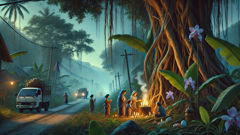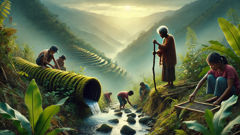Introduction
The first time Mara saw the Diwata she mistook their light for morning on the other side of the ridge: a trembling thread of gold that moved among the leaves like a shy promise. She was a child then, barefoot on the cold earth, fingers still sticky with rice, and the forest felt larger than the village and fuller of secrets. Her grandmother said the mountains breathed and the rivers remembered, that the Diwata lived in the hollow of a strangled fig and inside the mirror of a deep pool. The elders taught small, exact rituals—an offering of tubers wrapped in banana leaf, a whispered apology for cutting a branch, a song to keep rain from turning sour. Those lessons were not superstition but a grammar for living with a world that was both neighbor and kin. Years later, when the trees began to tremble for new reasons and a road’s iron teeth edged closer to the green, Mara would return to that early memory as to an anchor. The Diwata are described differently from one island to the next—some have hair like woven ferns, some glow with the blue of deep water, some ride the wind and speak in the language of birds—but whatever shape they took, they shared one task: tending the boundary between human want and the resilience of the land. This story moves with that boundary. It traces small acts of care and the loud, clumsy intrusions of change; it keeps the hush of offerings spoken under breath and follows the way a mountain watches over both danger and devotion. I will tell it to remember names: the name of the stream, the name of the tree between two rice paddies, the way a Diwata turned her head at the sound of a child humming. If you have walked the footpaths of the Philippines or seen the mist lay like a shawl across a village at dawn, you will know the feeling of being observed by something ancient and gentle. If you have not, then let the images stand alone: moss, limestone, the bright fish beneath water like coins, the slow work of roots. These pages gather the voices of the forest—bird-song, root-creak, the hush of old leaves—so we might understand, again and again, what it is to live beside the spirits who keep watch.
The Road and the Offerings
When the company sent its men with the flags and the clipped maps, the change arrived like a rumor first—workers arriving at dawn with thermoses and tape measures, a truck idling near the riverbank. The village woke to a different sound in the air: chain-link hums, diesel coughs, and the nervous chattering of people who had never learned to read the thin punctuation of a forest clearing. Mara, by then a young woman with the rhythm of the terrace in her hands, watched from the path that cut between coconut palms, where the tracks had been kept because someone, once, decided the land could be counted and parceled. The project was called progress on a paper and on a billboard that the wind peeled back like a secret; it promised a new road and lights and quick passage to the town. It promised, too, a different memory—one where the river runs between concrete walls and the mountain’s foot wears a road like a belt. The elders called a meeting at the largest nipa house. They arranged a row of small offerings: roasted camote, an egg, a smear of rice, a cup of fresh coconut milk. They spoke in the old way, measured and low. One of them, Aling Tiya Nena, caught Mara’s hand and pressed a palm to her wrist as if passing a pulse across generations. “Do not speak loud to the road,” she said. “The Diwata hear the sharp knife of a machine and the quietness that follows. They will answer in ways we cannot yet name.” The men from the company watched on the fringe, their boots clean, their faces practiced in blankness. Mara thought of the golden thread she had seen as a child and walked into the forest with that memory like a lantern. The offerings, wrapped in banana leaf and tied with rattan, were placed at the base of the strangler fig where the path forked. Mara sang a small song her grandmother had taught her and felt something like attention like warm breath cross her shoulders. It was not only superstition: the place was alive with a sound that belonged to tree and bird and insect as much as to any spirit. Days after the meeting, machines appeared, and the sound of iron on rock began its steady, accusatory chant. Men cut lines through brush and blasted small mouths into the slope. The forest did not give itself quickly. Vines that had watched centuries coil and rebuckle; birds that nested in ferned eaves took to shadowed branches; lichen dropped like old coins from bark. The company offered compensation and a timetable, but the village’s countersong was slower: a litany of small resistances. They left certain trees unmarked even though the map had not accounted for them; they placed extra offerings in the night when the men slept; they called the names of the streams out loud as if naming would anchor them. One morning, a trench collapsed into a sinkhole where a spring fed the river. Men peered into the black mouth and argued. The elders knew how to read the land’s answers. “The Diwata do not move without being asked,” Tiya Nena said. “We did not ask.” She proposed a procession to the ridge and a formal apology. The villagers gathered talisay leaves and small jars of vinegar, tied rice into sachets, and lit white candles that fluttered like moths in the dusk. Mara carried a bowl and a small, heart-shaped stone she had kept since childhood, smooth from the river’s touch. They walked without fanfare to the place where the machines had cut the first scar and waited as twilight bled into the green. Someone hummed a lullaby. Faces showed the strain of sleepless nights and the hope of making a truce. In the shadow of the upland trees, something moved that was not exactly wind. A chorus rose: frogs, an owl’s clear single-note, the scrape of a lizard. The candles leaned into the air as if listening. A light, little more than a breath, shimmered near the root of a broken tree, then another and another, until the clearing was threaded with a soft constellation. The Diwata had not arrived to fight, but to remind. They flitted close, then farther, like weather that measured its touch. One of them, pale as the inside of a shell, rested on Mara’s palm and made a sound that was not speech but not silence either; it felt like a stone settling into its place. It did not speak of magic in ways a child would want—no spells, no grand transformations—but it radiated a clear, inexorable intelligence: the forest had rules and memory, and human deeds bent them. The procession became more than ritual; it became a contract, the village promising to watch, to stop certain works, to mark sacred trees, to reroute the road’s curve so the spring would not be swallowed. The company men, confronted by policy and protest and a force that refused their counters, hesitated. They returned to their trucks and to meetings and to new maps that skirted the creek and left a strip of green as a seam between progress and place. Word of the Diwata’s attendance traveled to neighboring villages. Some called it superstition; some called it blessing. Those who had not known the sound of offerings now learned to lay simple things for the land: a cup of coffee at a crossroads, a bowl of rice on a stump, a song at a bridge. The rituals did not stop machines from arriving elsewhere nor erase the greed that would always find new mouths to feed, but they reshaped this particular place. In that season, Mara learned the delicate arithmetic of living beside a spirit world: you could ask and be refused; you could be ignored or tended to; you could be given a path that bypassed destruction. The Diwata’s attention was not guaranteed and could not be bought with cash. It required steadiness and a willingness to listen to the land’s logic rather than merely to measure its price. The road that returned to the village afterward was narrower, its curve gentler by the pool, and where it passed the strangler fig a small shrine had been built from river stones and woven palm, tended each week by those who remembered the night the lights came and the forest answered.

The Mountain’s Quiet Judgment
Beyond the terraces and the widened path, the mountain held other stories. It had a slow, layered patience, as if every rainfall and every footfall became a fold in its long memory. There was a place higher on the ridge where the soil grew thin and the trees knuckled like old hands. People said the Diwata there were older than the language they used, older than the sugar palms at the valley’s edge, older even than the first settlers who argued the ridge belonged to them. That is where Mara went after the road was rerouted, because decisions that save one pool often leave another unspoken harm. She wanted to understand how to keep promises that were more than signage. Her guide was an old man named Ka Lando, who had once been a logger and then stopped when his hands could no longer hold the saw with certainty. Ka Lando knew how to move in mountain silence; he had learned to read the dry twine of roots and to find caves by the taste of the air on his tongue. He taught Mara that the Diwata judged by rhythms—by the return of birdsong in spring, the clarity of a stream, the quietness of the soil when stepped upon. They kept a ledger of small things human eyes overlooked. The day they climbed was bright and crisp: a sun like a coin and a wind that smelled of crushed pandan. They crossed a ridge of ferns and palm and came upon terraces carved centuries ago, where ancestor hands had patterned the slope into ribbed paddies. A child—no more than seven—met them on the trail with a basket of greens, eyes wide as if seeing two ghosts at once. He told them the goats had refused the lower pasture and an old well had run thin without explanation. Ka Lando nodded and fed the boy a piece of bread without asking; the small courtesy was part of a thousand soft exchanges that keep a community from snapping. They reached a hollow lined with stones—a place where people used to leave cloth and small mirrors so the Diwata could see themselves. Mara set down her pack and felt the hush like cool water. She placed in the hollow the bowl of rice she had brought and, on impulse, a sprig of her mother’s perfume plant. Ka Lando began to chant a cadence that had no hurry, words she had not heard since she was a child. The chant was not a demand but an apprenticeship in patience. Hours passed and then the light shifted, and the air seemed to sharpen like a blade left bright in the sun. The Diwata arrived not as one but as a congress of presences: some like tall, reed-limbed women whose hair was a tangle of vines, others as birds with feathered halos, others as the less visible seep of attention that made the hair rise at the back of the neck. They examined the offerings with the seriousness of beings who had been hungry and generous both, and their faces were not necessarily kind in the human sense. Attention was its own verdict. Ka Lando spoke softly to them about the well and the goats and the new road’s stormwater that had been diverted without the grooves the earth needed. Mara watched the Diwata consider him, their eyes reflecting the cup of the sky. One of the forest Diwata, older than any of them, stepped forward. Its teeth were not shown in a grin but in a small clearing of moss, and when it smelled Mara’s perfume sprig, it paused and touched the leaf with a finger that was both root and human hand. It was a gesture like a ledger being balanced. Then the Diwata turned away from the hollow and walked out into the ridge as if to show them something. Mara and Ka Lando followed. They walked through groves where mist gathered and the mountain’s geometry shifted underfoot. The Diwata led them to a thicket where a small stream snaked and then disappeared into a broken pipe, a relic of a road-building crew that had attempted to force water into a culvert. Debris clogged the pipe: plastics, oil-stained rags, and the kind of waste that did not belong to the mountain. The Diwata tapped the pipe. The sound that came back was hollow and complaining. It had been muffled not by mystery but by human carelessness. The mountain’s judgment, in that moment, was plain and not punitive. It was a tally, a geometric accounting: you cut, you must mend; you divert, you must reweave the water’s old path. The Diwata made no speeches; they made changes that people could follow if they were willing. Over the next days the villagers worked with a stubborn tenderness. They cleared the pipe by hand, coaxed the stream back into its meandering course with woven planks and stones, and built a small filtration trough out of river rock so runoff from the road would slow and settle before entering the upper spring. They planted native shrubs to trap silt and taught the company’s younger surveyors—unexpected allies—how to test the water by taste and sight. Mara recorded the practices in a small book she kept in her bag: recipes for terraces, measurements for buffer strips, songs for coaxing rain. The Diwata accepted the work with a silence that was almost approval. The goats returned to the pasture and grazed without balking, and the well filled in the right season. People learned a new language of repair, a vocabulary of weaving and tending that matched the mountain’s patient grammar. Ka Lando said, “The Diwata will teach you how to live without losing the mountain,” and Mara understood that their teaching required humility rather than control. The Diwata’s jurisdiction was not limited to high places; they were the logic that argued for living with limits. Their power was not spectacle but the insistence that life is a ledger of debts and gifts. When a storm later came—one of those sudden tropics funnels that could break houses and wash roads away—the village’s narrow road held because the people had built terraces that could absorb and slow the water. Mud slid down slopes and stopped at the woven check dams; trees felled in the lower valley were used to block torrents rather than to clear them. The Diwata watched from the ridge in shapes too elegant for people to name, and though the tempest howled, the settlement endured with fewer scars. Afterward, when the smoke from cooking fires rose in thin columns, elders pointed to the mountain as if to a teacher: look what happens when respect and repair match greed and speed. The story traveled and became less about magic and more about a practical, shared ethic—call it folklore, call it science, call it devotion—the mountain’s quiet judgment had taught them ways to be better neighbors to their environment. Mara, holding Ka Lando’s weathered hand, felt the weight of that learning like a compass inside her chest. She began to walk to other communities, carrying her book and the small practices the mountain had taught. In markets and at road corners she traded instructions for a bowl of soup, for a woven mat, for the promise that someone might take a seedling and plant it where a sapling had died. The Diwata, in turn, met those acts with a steadying attention. They did not promise that every road could be stopped or that every harm would be undone, but they taught how to refuse easy harm and to design small, durable stitches that could hold a place together through storms. That was their power: a stubborn preference for continuity over conquest, for repair over replacement.

Conclusion
Years later, when Mara walked the terraces with a child at her hip and a notebook full of small repairs tucked into her bag, she thought often of how the story of the Diwata had changed shape in their valley. At first it had been a memory that consoled and frightened a child: lights among the roots that might take delight in you or withdraw their grace. Then it became a defensive language, a way to hold off greed and to slow down a road. Finally it settled into a daily practice that recognized the world’s limits—how much soil a slope could bear, how much water a spring could give, how much to take without asking. The Diwata were not guardians who did the work for people; they were neighbors who offered a different set of priorities and, sometimes, stern reminders. Mara learned to tell the story against many backdrops: in schoolrooms where children were surprised to hear about the reverence for a tree, among company men who sometimes listened and sometimes mocked, and in late-night kitchens where women sewed rattan and hummed songs that had become instructions. She learned that the spirits’ presence made a community ask better questions: what must we not take, and what must we give back? In that slow asking the village changed the calculus of daily life. They planted hedgerows, diverted runoff into settling ponds, marked sacred trees with paint and meaning, and taught their children the precision of offerings—small, neat, never extravagant, always with an apology when harm had been done. The Diwata’s influence spilled outward like a careful irrigation: other villages began to ask their own elders to teach the names of springs, to map shade trees, to design culverts that encouraged flow instead of bottling it. Those acts did not solve all the world's problems; roads still came where they must and companies still bought maps. But the valley became a place where decisions were debated in evening light and where the mountain’s ledger was consulted before a single tree was felled. Mara’s notebooks, filled with practices borrowed and adapted, became a small manual people read when a younger family moved into a place and did not know the old rules. She always wrote at the top of the first page a reminder her grandmother had given her: the land holds you as long as you remember that you are borrowed from it. On one evening, when the rain came in the kind of soft, thorough way that made the terraces drink and the air smell like renewed things, Mara sat at the shrine beneath the strangler fig and felt the place’s quiet attention. The Diwata hovered near, not glaring with drama but present like weather and memory. She offered a small cup of coconut milk, a handful of roasted peanuts, and a whispered thanks. The spirit that had once rested on her palm when she was small turned near the candle and, in a movement that she could not read as either blessing or presage, touched her hair as if marking time. Mara realized then that the story would continue, altered by each act of remembering and each act of forgetting. The Diwata would remain, as long as there were people willing to keep up the small trades with the land—rituals that were not static but practical: repairs, offerings, and the slow, stubborn work of listening. The valley would not be pristine, nor would it be protected against all harm, but it would be held by a chorus of living things and the arrangements humans had chosen to make with them. That, perhaps, was as much as anyone might expect: not a fairy-tale fortress against change, but a network of attention that nudged the future toward a place where roads might curve around springs and where a child could find a lantern of gold in the roots and understand, without fear, that there were guardians in the world who kept watch.

















